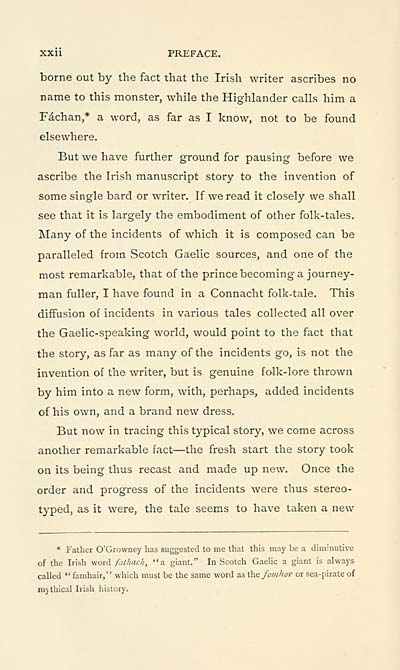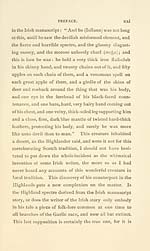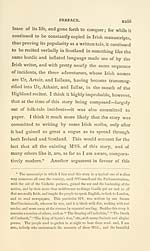Blair Collection > Beside the fire
(26)
Download files
Complete book:
Individual page:
Thumbnail gallery: Grid view | List view

XXU PREFACE.
borne out by the fact that the Irish writer ascribes no
name to this monster, while the Highlander calls him a
Fáchan,* a word, as far as I know, not to be found
elsewhere.
But we have further ground for pausing before we
ascribe the Irish manuscript story to the invention of
some single bard or writer. If we read it closely we shall
see that it is largely the embodiment of other folk-tales.
Many of the incidents of which it is composed can be
paralleled from Scotch Gaelic sources, and one of the
most remarkable, that of the prince becoming a journey-
man fuller, I have found in a Connacht folk-tale. This
diffusion of incidents in various tales collected all over
the Gaelic-speaking world, would point to the fact that
the story, as far as many of the incidents go, is not the
invention of the writer, but is genuine folk-lore thrown
by him into a new form, with, perhaps, added incidents
of his own, and a brand new dress.
But now in tracing this typical story, we come across
another remarkable fact — the fresh start the story took
on its being thus recast and made up new. Once the
order and progress of the incidents were thus stereo-
typed, as it were, the tale seems to have taken a new
* Father O'Growney has suggested to me that this may be a diminutive
of the Irish word fathach, "a giant." In Scotch Gaelic a giant is always
called " famhair," which must be the same word as \\\q. foinhor or sea-pirate of
mythical Irish history.
borne out by the fact that the Irish writer ascribes no
name to this monster, while the Highlander calls him a
Fáchan,* a word, as far as I know, not to be found
elsewhere.
But we have further ground for pausing before we
ascribe the Irish manuscript story to the invention of
some single bard or writer. If we read it closely we shall
see that it is largely the embodiment of other folk-tales.
Many of the incidents of which it is composed can be
paralleled from Scotch Gaelic sources, and one of the
most remarkable, that of the prince becoming a journey-
man fuller, I have found in a Connacht folk-tale. This
diffusion of incidents in various tales collected all over
the Gaelic-speaking world, would point to the fact that
the story, as far as many of the incidents go, is not the
invention of the writer, but is genuine folk-lore thrown
by him into a new form, with, perhaps, added incidents
of his own, and a brand new dress.
But now in tracing this typical story, we come across
another remarkable fact — the fresh start the story took
on its being thus recast and made up new. Once the
order and progress of the incidents were thus stereo-
typed, as it were, the tale seems to have taken a new
* Father O'Growney has suggested to me that this may be a diminutive
of the Irish word fathach, "a giant." In Scotch Gaelic a giant is always
called " famhair," which must be the same word as \\\q. foinhor or sea-pirate of
mythical Irish history.
Set display mode to: Large image | Transcription
Images and transcriptions on this page, including medium image downloads, may be used under the Creative Commons Attribution 4.0 International Licence unless otherwise stated. ![]()
| Early Gaelic Book Collections > Blair Collection > Beside the fire > (26) |
|---|
| Permanent URL | https://digital.nls.uk/76243981 |
|---|
| Description | A collection of Irish Gaelic folk stories. |
|---|---|
| Shelfmark | Blair.222 |
| Additional NLS resources: | |
| Attribution and copyright: |
|
| Description | A selection of books from a collection of more than 500 titles, mostly on religious and literary topics. Also includes some material dealing with other Celtic languages and societies. Collection created towards the end of the 19th century by Lady Evelyn Stewart Murray. |
|---|
| Description | Selected items from five 'Special and Named Printed Collections'. Includes books in Gaelic and other Celtic languages, works about the Gaels, their languages, literature, culture and history. |
|---|

